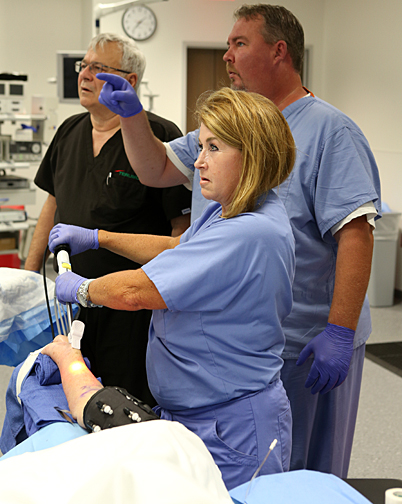The number of learners coming through The University of Toledo Jacobs Interprofessional Immersive Simulation Center continues to grow.
The simulation center has trained, on average, 2,000 learners per month since opening in April 2014, according to Ben Stobbe, administrative director and business manager of the center.
Stobbe attributes the growth to more UT departments taking advantage of the state-of-the-art technology and the innovative, hands-on opportunities to aid students in their studies, as well as external companies utilizing the center to provide training via surgical workshops.

Julie Nelson practiced radial artery harvest surgery on a cadaver as Gary Tindel, center, noted how the technique was proceeding on the screen as Larry Pizzola watched. The training was being conducted by Ann Arbor-based Terumo, which visited the Jacobs Interprofessional Immersive Simulation Center last month.
“Faculty members are energetic and want to use the technology to supplement their curriculum,” Stobbe said. “Students are learning in a safe environment away from the patients. They can practice and then take a pause and ask themselves, ‘What should I do next?’ You can’t do that in the clinical environment.”
The simulation center, which is three stories and 65,000 square feet, is the first in the nation to incorporate three integrated simulation centers: a progressive anatomy and surgical skills center, an advanced clinical simulation center, and the virtual immersive reality center. In addition, the technology can be used in nonmedical fields, including (but not limited to) the arts, humanities, natural sciences and engineering.
Jennings Smith, instructor in the College of Nursing, uses the simulation center to help first-year nursing students understand cranial nerves. Within the Virtual Immersive Reality Center, a 3D model of the cranial nerves is displayed on the large curved computer-aided design wall, which allows for interaction that cannot be replicated in a traditional lecture setting.
“The students really liked the interactive image because they can practice locating the cranial nerve, which is something that is hard to do with a 2D image,” Smith said. “I think the simulation center is a valuable tool for our students, and I plan to continue to develop curriculum that can benefit from such a setting.”
Stobbe said the simulation center is appealing to outside agencies as well. For instance, city of Toledo paramedics use the center for emergency training.
“We even have had interest for high-end homebuilders to come in and show clients what the design of their potential homes could look like,” Stobbe said. “We also hosted the 2014 International Visual Literacy Conference for the Toledo Museum of Art. We re-created some of the rooms of the art museum for the conference, providing a virtual tour.”
In the first fiscal year, 34 surgical labs were conducted on the third floor of the center, which is where the surgical bays are located to work on cadavers. This opportunity is becoming so popular that there were eight labs in July alone.
The newest business opportunity is outside surgical companies paying for access to the center; this accounts for 10 percent of its usage. UT faculty, staff and students can use the facility at no cost.
Bob Langford, manager of Ann Arbor-based Terumo, brought in a team to practice radial artery harvest surgery on a cadaver. Normally, he would need to travel to Chicago or Houston for this level of training.
“This is so much more convenient because we are only 45 minutes away from top-of-the-line training technology,” Langford said. “It is always beneficial to get away from the clinical environment and get into a training environment because we can take our time using the equipment and make adjustments in a low-pressure setting.”